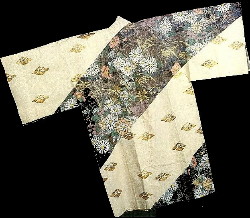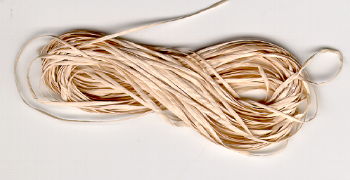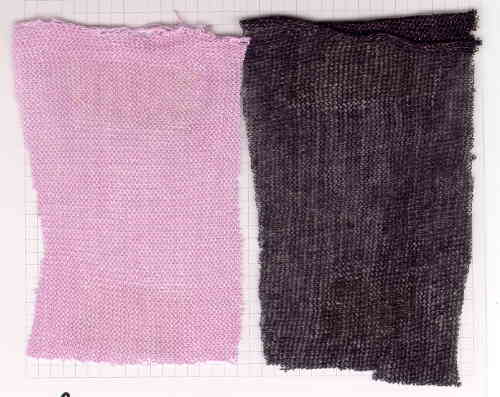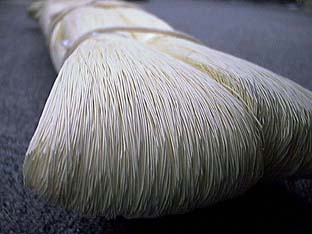

|
|

Paper yarn

Paper yarn
Introduction
Shifu (Clothing Woven With Washi yarns)
Washi paper is cut into long, narrow ribbon-like strips which are twisted on
a spinning wheel, then woven like silk or cotton, traditionally on a handloom.
For the warp and the weft of this paper fabric, there are cases in which silk or
cotton is used for the warp but when woven there is little difference from
ordinary cloth.
Properties
Paper fabric has the drawback of tearing when it becomes wet in the rain but
paper fabric can be laundered. Its tradition still remains, although on a
limited scale now, as high-class clothing.
Paper yarns are subject to customs tariff 5308.90xx
Applications
- High fashion items
(knitting, hand knitting)
- Handicraft items

Paper yarns give a fabric a
very nice dry and crispy hand
Traditional Materials Find New Application in
Clothing
The fashion world is constantly seeking and latching onto new
materials. The folk fashion craze spurred demand for natural,
handmade-looking textiles that exude warmth, while synthetic
fabrics with a sleek look have also recently been popular. One
of the hot items is fabrics made from traditional
Japanese materials, such as bamboo and washi (handmade
Japanese paper).
A spotlight grabber in Tokyo
presented a series of coats and pants made of fabric
containing bamboo fibers. Paper clothing is also coming out. Apparel makers began
offering summer sweaters knitted from fibers made of washi, and they plan to expand their lineups of washi
clothing for heavier fall fashions too. Jackets, sweaters, and pants for men are
also available. The 100% washi fabric is light and
breathable and feels a lot like linen. This fabric
also absorbs dust and odors, as evidenced by the fact that it
is used as filters in air-purifying devices.
Washi and bamboo are not the only traditional
materials being used in clothing. Jackets and pants made of a
new materials like polyester charcoal have also
come up. The charcoal is pulverized, then mixed into a
polyester solution to produce an exceptionally resilient,
lustrous fabric that also reportedly has deodorizing
properties.
The Road to Paper Clothes
Research toward creating paper clothing has been under way in
Japan for a long time now, though it has never before reached
the practical application stage. In February 2000, 10 artisans
and designers who belong to a washi research group held
an exhibition exploring the possibilities of washi at a
gallery in Kagoshima Prefecture. The articles on display
included clothing, such as jackets colored with dyes made from
paper mulberry (one of the raw materials commonly used to make
washi). The clothing, which appears stiff but feels
soft and warm, got high marks. In March 1999 a fashion show
featuring clothing made of washi was held in Kochi
Prefecture. Washi jeans were among the articles that
appeared in the show, which was titled "The Body of
Washi." One would never know, just by looking at these
clothes, that they are made of paper.
The merits of paper for use in textile fibers
are their breatheability (ideal for humid summers), the
ease of processing them into fabric, their high functionality,
and their beauty. The fashion world's fascination with all
things Oriental and Japanese continues unabated, and washi
product are attracting the interest of a growing number of
designers. More and more of this material is expected to
find its way onto store shelves as time goes by.
|
Grades
- twisted paper
yarns
- paper yarn mixed with
polyester
|
We are able to supply paper
yarn produced of slit widths of 2 mm, 3 mm, 5 mm, 10 mm and
15 mm in natural white as well as in dyed. Upon demand paper
yarn can be twisted together with polyester filament yarns.
We are serving all customers
who are able to purchase a minimum of 500 kgs per order.
|
|
Paper yarns
- please click on image to get a bigger one
|
| Processability

|
| Background
information

Washi is the Japanese word for the
traditional papers made from the long inner fibres of three
plants, wa meaning Japanese and shi
meaning paper. As Japan rushes with the rest of the world
into the 21st Century, and more modern technologies take
over, machines produce similar-looking papers which have
qualities very different from authentic washi. As of the
fall of 1994, there still remain roughly 350 families
still engaged in the production of paper by hand.
History
Though paper was originally made in
China in the first century, the art was brought to Japan in
610 AD by Buddhist monks who produced it for writing sutras.
By the year 800, Japan's skill in papermaking was
unrivalled, and from these ancient beginnings have come
papers unbelievable in their range of colour, texture and
design. It was not until the 13th century that knowledge of
papermaking reached Europe -- 600 years after the Japanese
had begun to produce it. By the late 1800's, there were in
Japan more than 100,000 families making paper by hand. Then
with the introduction from Europe of mechanized papermaking
technology and as things "Western" became sought
after including curtains and French printmaking papers,
production declined.
RAW MATERIALS
The inner barks of three plants, all
native to Japan, are used primarily in the making of
washi:
- Kozo (paper mulberry) is
said to be the masculine element, the protector, thick
and strong. It is the most widely used fibre, and it is
the strongest. It is grown as a farm crop, and
regenerates annually, so no forests are depleted in the
process.
- Mitsumata is the
"feminine element": graceful, delicate, soft
and modest. Mitsumata takes longer to grow and is thus a
more expensive paper. It is indigenous to Japan and is
also grown as a crop.
- Gampi was the earliest and
is considered to be the most noble fiber, noted for its
richness, dignity and longevity. It has an exquisite
natural sheen, and is often made into very thin tissues
used in book conservation and chine colle printmaking.
Gampi has a natural 'sized' finish which does not bleed
when written or painted on.

METHODS OF PRODUCTION
Branches of the (kozo, gampi or
mitsumata) bush are trimmed, soaked, the bark removed, and
the tough pliant inner bark laboriously separated, cleaned,
then pounded and stretched. The addition of the pounded
fibre to a liquid solution, combined with tororo-aoi
(fermented hibiscus root) as a mucilage, produces a
paste-like substance when it is mixed.
It is this "paste" which is
tossed until evenly spread on a bamboo mesh screen to form
each sheet of paper. The sheets are piled up wet, and later
laid out to dry on wood in the sun or indoors on a heated
dryer.
Winter Activity
Papermaking in Japan was a winter activity. It was
slack-season work for farmers, and this allowed it to be
made wherever there was a good and abundant supply of
soft, running water and where the bast fiber plants
could grow--a perfect industry for a mountainous country
with heavy rainfall and short, swift rivers.
|
| Our
supplier partner
|
|
|












